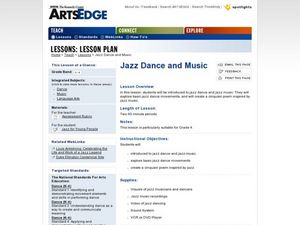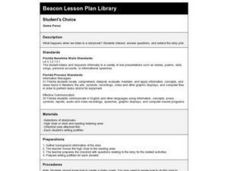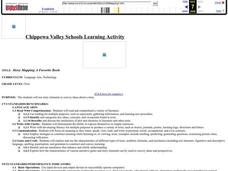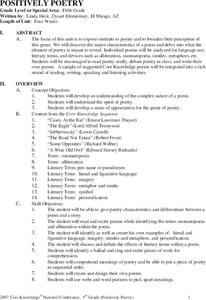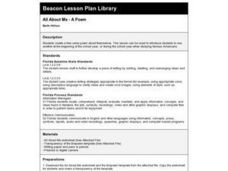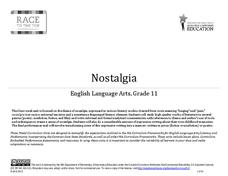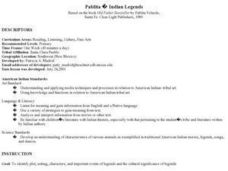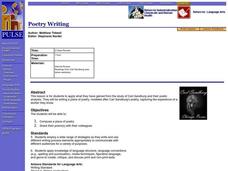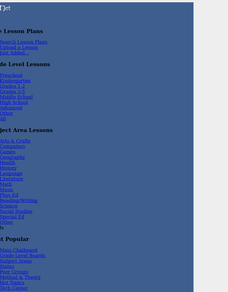Curated OER
Runny Babbit
Students are introduced to elements of poetry through the book Runny Babbit. In this poetry lesson, students learn about the newest Shel Silverstein book, then examine the poem's form, rhythm, and rhyme. Students look for other Shel...
Curated OER
Making Recycled Paper
Students explore the advantages of recycling paper. In this environmental lesson, students produce recycled paper by ripping up paper and putting it into a blender with water to create a mixture. Students use their recycled paper to...
Curated OER
Jazz Dance and Music
Fourth graders write a poem. In this jazz music lesson, 4th graders learn about the basics of jazz dance and practice basic movements. Students learn common terminology and listen to several recordings of jazz music. Students create a...
Curated OER
Writing
Students write poems and a narrative story. In this writing lesson, students read stories and poems written by other students and read examples of haiku's and diamonte's. Students write an acrostic poem and a diamonte...
Curated OER
STUDENT'S CHOICE
Learners interact, answer questions, and extend the story plot. They write a Haiku or basic poetry with their words, name characters, create a new ending for a story, and write a new story with one of the characters.
Curated OER
Story Mapping A Favorite Book
First graders create a diagram of a story by using the computer program Kidspiration. In this diagramming lesson plan, 1st graders will pick a book to write about. They then will plug in story elements of the book into the computer...
Curated OER
Heaven or Ground Hog Day?
Students discover the ideas of enlightenment by reading historical poetry. In this philosophical instructional activity, students read poems by Sir Walter Scott and Sergeant Joyce Kilmer while discussing the themes of the writing with...
Curated OER
"Declaration (of a Kgomotso Girl)"
Students explore the poem, "Declaration." Students discuss how elements of poetry such as tone work to convey meaning. Students compare and contrast their lives and the lives of the poem's characters from South Africa.
Curated OER
Do You Haiku?
After examining several Haiku and noting characteristics of the form, class members create five of their own poems. Use this resource for extra practice or review.
Curated OER
Found Poetry with Primary Sources: The Great Depression
Students read a sample found poem and create one together as a class. In this Great Depression lesson, students select a topic, such as miners, and read primary source documents related to the topic. Students select one narrative as the...
Curated OER
Positively Poetry
Students complete a unit on poetry. In this poetry lesson, students complete 19 lessons that focus on reading and writing poetry as well as learning about literary elements and sound devices. Students read poetry orally, debate poetry in...
Curated OER
This Isn't Your Little Sister's Poetry: Analyzing and Understanding a Variety of Acclaimed Poets
Eleventh graders are introduced to various basic and advanced poetic devices. They read several poems and practice identifying poetic elements. They identify at least two different poems and substantiate why they belong in the canon.
Curated OER
All About Me - A Poem
Second graders brainstorm unique qualities they possess in a All About Me worksheet. They write free verse poems about things that most people don't know about them. They brainstorm descriptive words to enhance their poems and rewrite them.
Curated OER
Our Town
With the songs "My Hometown" by Bruce Springsteen and "Allentown" by Billy Joel, learners examine external versus internal conflict. When they have finished the first part of the lesson, they create their own poem (or song) about the...
Massachusetts Department of Education
Nostalgia
To prepare for crafting their own memoir, class members examine poetry by Margaret Atwood, Billy Collins, Robert Hayden, and Claude McKay, stories by Richard Rodriquez and Willa Cather, and Barry Levinson's film Avalon. They examine...
Curated OER
Be the Poet
Students work through a Haiku Organizer to determine the characteristics they use to write eight haiku poems on a theme that they choose. They design presentation folders of their completed work.
Curated OER
Pablita Indian Legends
Scholars are introduced to the characteristics of a legend. They read and discuss Old Father Story Teller by Pablita Velarde. Then, in groups, they write and illustrate a poem based on one of the legends from the book. This lesson plan...
Gottlieb
Kennings vs. Stock Epithets – A Quick Review
Bone-crusher. Troll-wife. Battle-sweat. Blood-worm. What study of Beowulf would be complete without offering readers of this Old English epic poem an opportunity to craft their own kennings and epithets? Provide individuals with a copy...
Novelinks
Tuck Everlasting: Similes, Metaphors, and Personification in Imagery
Poetic language is abundant in Natalie Babbitt's beautiful novel, Tuck Everlasting. Learners note the examples of similes, metaphors, and personification they find as they read, and illustrate how the language creates a sensory...
Curated OER
Poetry: A Picture of Feelings
Students take a field trip to a place of interest. After the trip they share with a partner their most memorable memory about it. Later, they paint a picture representative of the trip and illustrate it with a poem using at least two...
Curated OER
Emily Dickinson Poetry
Students identify a poem by Emily Dickinson for analysis. They apply a set of critical questions to a poem in order to interpret poem and find literary elements used by author. They organize information for a PowerPoint presentation...
Curated OER
Poetry Writing
Students compose a piece of poetry modeled after the poetry of Carl Sandburg and share their poem(s) with their colleagues. They use a cluster diagram to organize their thoughts and brainstorm their ideas.
Curated OER
Newspaper Poems
Ninth graders appreciate the value of words, review the parts of speech, create original poetry, shape the poem, and write an explanation of the images he/she has created.
Curated OER
Poetry: Using Prosodic Devices
Students examine poetry examples in free verse focusing on their prosodic elements. After critiquing works by several authors, they write their own poems utilizing such devices as alliteration, repetition, rhyme, and stanzas.
Other popular searches
- Elements of Poetry
- Elements of Poetry Analysis
- Literary Elements of Poetry
- Elements of Dramatic Poetry
- Four Elements of Poetry
- Naming Elements of Poetry
- Thematic Elements of Poetry
- Elements of Poetry Notes
- Teaching Poetry Elements
- Elements of Poetry Lessons
- Elements of Analyzing Poetry
- Elements of Japanese Poetry




